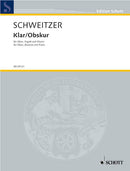| 作曲者 | Benjamin Schweitzer |
| タイトル | Klar/Obskur |
| 出版社 | Schott・ショット |
| 楽器編成 | oboe, bassoon and piano |
| 品番 | 9790001146449 |
| 難易度 | 上級 |
| 形状 | 76 ページ・中綴じ |
| 演奏時間 | 10分 |
| 作曲年 | 2006年 |
| 出版年 | 2007年 |
| 出版番号 | ED 20121 |
| ISMN | 9790001146449 |
| その他 | 3 copies |
The chiaroscuro-technique developed by painters of the Italian renaissance served to intensify contrasts and effects of optical depth. In Klar/Obskur, I tried to transfer the general idea of this technique on the rather unusual instrumentation of two double-reed woodwinds and piano. On the one hand, a clear, well articulated playing is characteristic for these instruments, on the other hand, they have an often underestimated potential of „twilight“: air-sounds and fragile, shady colours have a especially attractive when being produced by double-reed instruments (which are often, and superficially regarded as being less capable of differentiated sounds than flute or clarinet). The piano, too, has a broad bandwidth of possibilities between percussive and delicate playing to complement the woodwinds which, in return, can absorb and continue the fading piano sounds.The beginning introduces the two contrasting elements that form the basic material for the piece: a clear, sharp chord, followed by fragile, dim sounds. The changes between these elements as well as their combination and amalgamation produce an enormous spectrum of colours and gesture. After this „motto-like“ opening follow four quite clearly separated short sections, each of them being characterised by a well-defined texture: a partly almost imperceptible air-sound passage, a short sequence of microintervallic notes, a burst of virtuosity and a recourse to the fragile sounds of the beginning.The second, longer main part consists of three sections merging subtly into each other: a short unisono-passage, marked elastic [federnd], is being dissolved into its basic elements, from these remainders, a confrontation of low, ‚arcane‘ bassoon and piano sounds and a strongly ornamented melodic line of the oboe emerges, leading to a short but powerful climax. The piece is concluded by an extended, relaxed epilogue, containing a short piano solo and a duet of oboe and bassoon and, finally, a quotation of the „elastic“ character of the middle section.Benjamin Schweitzer



